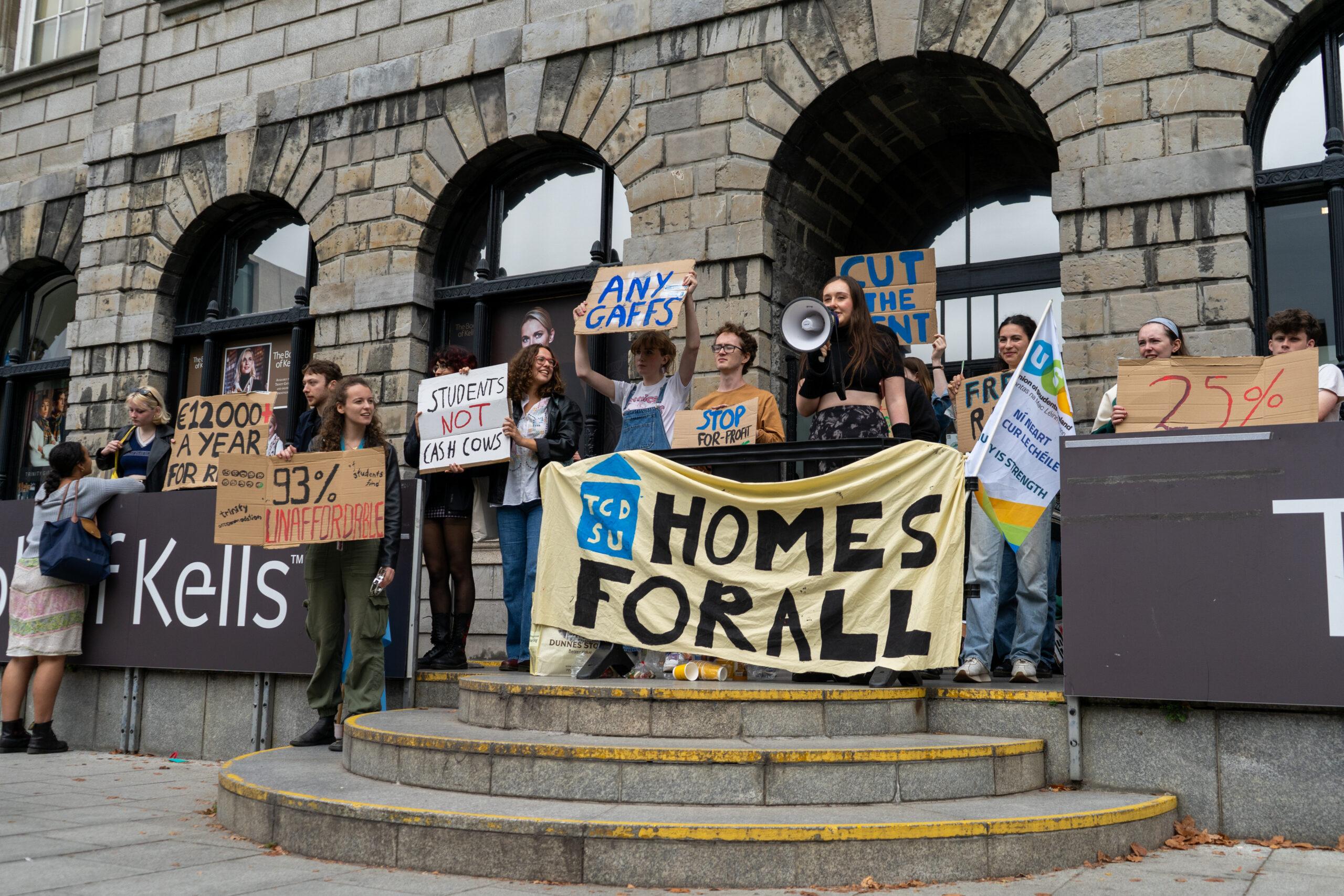Trinity College Dublin Students’ Union (TCDSU) recently organised a blockade of the Book of Kells in protest of College raising the rent by the maximum legal amount. The day-long protest saw College lose thousands of euros through refunds to tourists who could not gain access to the Long Room and garnered huge media attention across the country. The recent blockade indicates a return to form for student protest. However, this kind of protest is only effective when it is as consistent as it is disruptive.
The last major protest to occur on campus was Take Back Trinity in 2018, a protest prompted by the introduction of a €450 exam resit fee. This protest was consistent in its disruption, including using blockades at College’s Front Arch and at the Book of Kells. They also staged a days-long occupation of the Dining Hall which quickly escalated to an occupation of Front Arch when College hired Noonan Security Company to block the entrances to the Dining Hall completely.
The most important thing about this protest however, is that through the level of consistent disruption it caused for College, they were successful in their aims. Several areas of the College were targeted consistently by protestors, and during the Dining Hall sit-in, 60 students reported to be without access to food, water or toilets. Trinity had to relent and abolish the supplemental exams fees.
“Almost all the students in College currently are not old enough to remember Take Back Trinity, but the impact of this direct action cannot be understated”
Almost all the students in College currently are not old enough to remember Take Back Trinity, but the impact of this direct action cannot be understated. It is the last time College was forced to relent on such a massive policy, and it only happened because of how consistently disruptive the direct action was. Much like many tourists at the blockade languished missing their chance to see the Book of Kells, many students, staff and tourists might have been irritated having spaces disrupted for days by Take Back Trinity – but doing this ensured students would not have to pay exorbitant fees to retake exams.
While not all the successes of the protest remain, such as a broken pledge to halt increases in international student fees, Take Back Trinity demonstrated the power of stubborn student action. Action which has been missing from student politics for several years.
“Weeks of USI and student unions promoting this walkout culminated in the equivalence of a fire-drill”
There is no starker example of ineffective disruption than the national USI walkout last year. On 13 October, 2022, thousands of students walked out of lectures at 11.11am in protest of the rising cost of living. What should have been one of the largest disruptions to third-level education was instead a demonstration that was barely worth putting on Simon Harris’ radar. This protest was polite. This protest was endorsed by lecturers, many of whom cancelled their lectures so students had nothing to walk out of. This protest had a stamp of approval from Provost Linda Doyle, the head of an institution this walkout was aimed against. There were scheduled speeches and a scheduled end time to the protest. People walked straight back to classes and cleared out of Front Square in a timely and orderly manner. Weeks of USI and student unions promoting this walkout culminated in the equivalence of a fire-drill. How effective can protest really be when students are being given permission to do it?
The momentum of this large protest was completely lost after the walkout. All of the momentum of a national protest organised by the national union was squandered by a lack of follow up action. In its lackof consistent disruption this protest only served as a minor blip in the College year that Trinity and other universities could easily ignore. The demands of that protest were not met because the activists involved were not consistently disruptive enough to insist that they were met.
The COVID-19 pandemic put a stop to student protest and protests that were started before the pandemic lost their momentum. While this was unavoidable at the time, there are lessons to be learned from Take Back Trinity and other similar protests. These lessons are from a generation of students who are no longer in College and now for the first time since 2018, students have picked up a similar mandate: They will disrupt College’s income sources until their demands are met.
However, this action will only be successful in its aims if it uses the momentum it has garnered from the blockade. Eight hours of roughly 50 students standing in front of a door has had more impact than any other demonstration in years. But having the Book of Kells return to business as usual will not force College into implementing any change. Activists need to show College that they are here to stay and they will disrupt College’s income until their demands are met.
So far, in the wake of this protest they have not. Direct action like this is effective, Take Back Trinity showed that, but the fundamental difference here is that they refused to relent in their disruption until their demands were met. If we are to take any lesson from Take Back Trinity it should be that consistency is key in achieving these demands.
Leaders in both TCDSU and USI have pledged that this year will be different and it is important that it is. The cost of living is astronomical and students are dropping out because they cannot afford their housing. Something has got to give and students like the ones that have been most recently elected have pledged to be unapologetic in ensuring this. They have taken the first step with this protest, but they run the risk of losing this momentum if they do not follow it up. Immediately.






